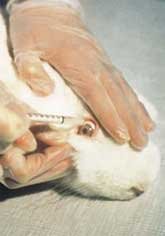
By purchasing only cruelty-free products, you can help save rabbits, mice, guinea pigs, rats, and other animals.
Hundreds of thousands of these animals are poisoned, blinded, and killed every year in outdated product tests for shampoos, household cleaners, cosmetics, hairspray, and other personal care and household items.
Over 500 companies have banned all animal tests forever, including some major ones.
But some corporations, including Procter & Gamble, Clorox, S.C. Johnson, and others, still test on animals, by pouring toxins onto animals' shaved, abraded skin, or squirting chemicals into animals' eyes, or forcing substances into their lungs, or pumping them into their stomachs.
These archaic tests are usually not required by law, and they often produce inaccurate or misleading results. And they don't protect consumers: even if a product has blinded an animal, it can still be sold to you.
Fortunately, scientists have developed many sophisticated non-animal product tests now in use today that are faster, cheaper, and far more accurate at predicting human reactions to a product than old blinding and poisoning animal tests, which were developed in the 1920s, ever were.
Human cell cultures and tissue studies (in vitro tests) and artificial human “skin” and “eyes” mimic the body’s natural properties, and a number of computer virtual organs serve as accurate models of human body parts.
Instead of measuring how long it took a chemical to burn away the cornea of a rabbit’s eye, manufacturers could now drop that chemical onto donated human corneas. Human skin cultures could be grown and ordered for irritancy testing.
Please vow never to buy products from companies that use animals.
Draize Eye Test - eye irritancy test on rabbits for cosmetic productsThere are a broad range of animal experiments used to test cosmetics and toiletries. These are some of the most commonly used tests.

Eye irritancy
Also known as the Draize Eye Test, this is used to assess the acute irritancy of a substance when applied directly to the eye. It usually uses at least three adult albino rabbits per substance. The substance is dripped into one eye of each conscious rabbit, often immobilised in stocks for dosing, whilst the other non-tested eye serves as a control. Rabbits have far less tear flow than humans and are therefore less able to 'cry away' painful substances, which is one of the reasons why scientists use this species. Rabbits also have no blink reflex, which makes applying the chemicals easier. During the tests, damage to the eyes such as cloudiness, reddening, lid swelling, ulceration or weeping eyes is recorded over a 21 day period for a single dose. No pain relief is normally given.
Skin irritancy
Used to assess the toxicity of a substance applied to the skin. It uses at least three adult abino rabbits or guinea pigs per substance and involves applying the test substance to their shaved and abraded (scratched) back. Over hours, day or weeks, any signs of redness, swelling, inflammation, skin cracking and ulceration are recorded. No pain relief is normally given.
Acute toxicity
There are many different types of toxicity (poisoning) experiments. This one is to assess the toxic effects on the whole body of a single dose of a substance. It usually uses 15-30 rats per substance and is administered either by force-feeding (oral), injection or inhalation, usually without any pain relief. The animals are housed for a minimum of five days to 'acclimatise' before being dosed with the substance and observed for 14 days. Animals being dosed orally will be starved before testing. Symptoms include blood pressure changes, weight loss, excessive salivation, internal organ damage, breathing disturbances, convulsions, bleeding from eyes, nose or anus, pilo-erection (hair standing on end), tremors, diarrhoea, coma and even death. All the animals are killed at the end of the test for autopsy.
No comments:
Post a Comment